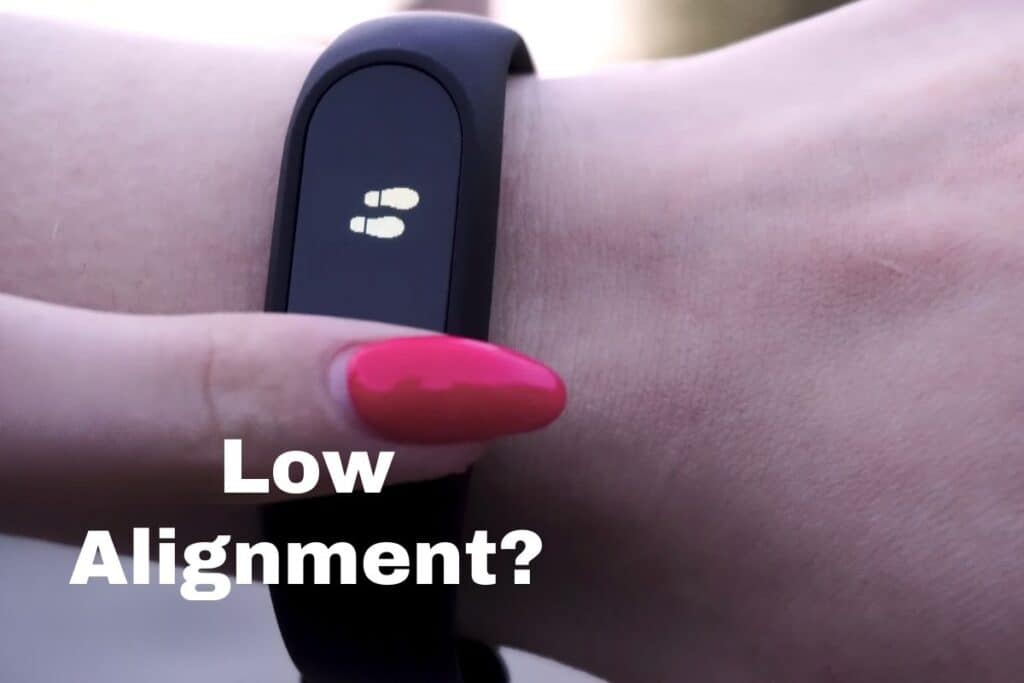Here’s What Low Alignment Means On Fitbit
Have you noticed a notification flashing on your Fitbit device showing “low alignment”? It can be confusing for you, and here is what it means:
Low alignment means that there is a mismatch between your body’s orientation and what Fitbit’s sensors are detecting. That can be caused by things like wearing the tracker too loosely on your wrist, having an improper fit, or performing activities with significant arm movement.
We have troubleshooted tons of Fitbit trackers and other gadgets like that and can provide you with the best possible solutions to your problems. As experts in Fitbit trackers and gadgets we have all the answers you want for troubleshooting your devices. Read on to learn more about it.
What Does Low Alignment Mean in Breathing?
Low alignment in breathing means that the body is relying on inefficient and unhealthy patterns of breathing. This can lead to shallow, upper chest breathing, which can contribute to poor posture, negative mental states, fatigue, and a lack of proper oxygen delivery to the cells of the body.

Low alignment in breath also refers to weak intercostal muscles (the muscles between the ribs) leading to difficulty controlling both the inhalation and exhalation phases of respiration.
Low alignment in breath often causes an imbalance between sympathetic (fight or flight) and parasympathetic (rest and digest) responses, causing stress hormones such as cortisol to remain elevated for too long throughout our day-to-day lives.
Practicing mindful breathing techniques with awareness and intention can help restore alignment in breathing patterns and bring the body back into balance.
By focusing on alignment as we breathe, we can improve our overall health, mental clarity, posture, and well-being.
Through consistent practice of mindful breathwork techniques, such as diaphragmatic breathing or belly breathing, we can train the body to move away from shallow chest-oriented breaths towards a more holistic approach that allows us to access the full volume of air available to us with each inhale and exhale.
This helps create an even flow of oxygen throughout the body while also triggering a relaxation response in our nervous system so that we can better cope with external stressors. Properly aligned breathwork also strengthens intercostal muscles and improves the coordination of inhalation and exhalation, allowing us to gain better control over our breathing.
By practicing mindful breathwork daily, we can help restore balance in our bodies and live healthier and more fulfilling lives.
Why Does My Fitbit Say Relax?
When your Fitbit says “Relax,” it is prompting you to take a moment to pause and focus on calming activities. While wearing a Fitbit, stress can accumulate over time, as the device tracks and stores data about your daily physical activity level.
By taking a few minutes out of your day to relax, you can reset your body and mind and help reduce overall stress levels.
Relaxation techniques such as deep breathing, progressive muscle relaxation, guided imagery, or mindfulness meditation can be helpful for reducing stress. In addition, engaging in hobbies that bring joy such as painting or listening to music may also benefit those trying to reduce long-term stress.
Taking frequent breaks throughout the day is beneficial for both mental and physical health; by acknowledging when something is making you feel stressed and taking the time to relax, your Fitbit can help you stay balanced.

How Do I Relax My Fitbit?
Relaxing your Fitbit is important for getting the best performance out of it. There are a few simple steps you can take to ensure that your Fitbit is relaxed and ready for use:
- Remove the band from your wrist and place it in a safe location away from direct sunlight, heat, and moisture.
- Allow your Fitbit to rest for at least 30 minutes so that its sensors can cool down and reset after any strenuous activity.
- While your Fitbit is resting, clean off the outside with a soft cloth or cotton swab to remove sweat, dust, and dirt buildup. Make sure not to use harsh chemicals or cleaners on the device as this could damage it.
- When you’re ready to use your Fitbit again, make sure the band is securely fastened and centered on your wrist for the best accuracy and performance.
- Take a few deep breaths before starting any activity to ensure you are relaxed and your body is not tensing up too much as this can affect the accuracy of your readings.
By following these steps, you can help ensure that your Fitbit remains relaxed and ready for use so you can get the most accurate readings.
How Do You Fix Low Breathing?
If you have low breathing, it’s important to take action right away. Make an appointment with your healthcare provider to discuss the possible causes and treatment options. Depending on the underlying cause, they may recommend lifestyle changes, medications, or other treatments to help improve your breathing.
Lifestyle changes can make a big difference in improving your breathing. If you smoke, quit immediately. Avoid air pollution whenever possible and limit exposure to dust and chemical fumes.
Exercise regularly as this can help strengthen your lungs and increase their capacity for oxygen intake. Additionally, practicing stress management techniques such as yoga and meditation can be beneficial for people with low breathing rates due to anxiety or panic disorders.
Your doctor may also prescribe medication such as bronchodilators or corticosteroids to help reduce inflammation in the airways and improve breathing. In some cases, oxygen therapy may be recommended. This involves administering supplemental oxygen to treat chronic hypoxia (low levels of oxygen in the blood).
Surgery is sometimes necessary for people with severe issues such as chronic obstructive pulmonary disease (COPD) or emphysema. It may also be used to repair a collapsed lung or remove tumors from the lungs that are blocking airflow.
In some cases, lifestyle changes alone may not be enough and other treatments such as medications and/or surgery will become necessary. If you have any symptoms of low breathing, it’s important to discuss them with your doctor right away. Taking the proper steps to diagnose and treat the underlying cause can help ensure you have a healthy, normal breathing rate.
Key Takeaways
- Low alignment can be due to incorrect wrist placement.
- Ensure your device is securely fastened to your wrist.
- Relaxing your Fitbit is important.
- Take action right away if you have low breathing.
